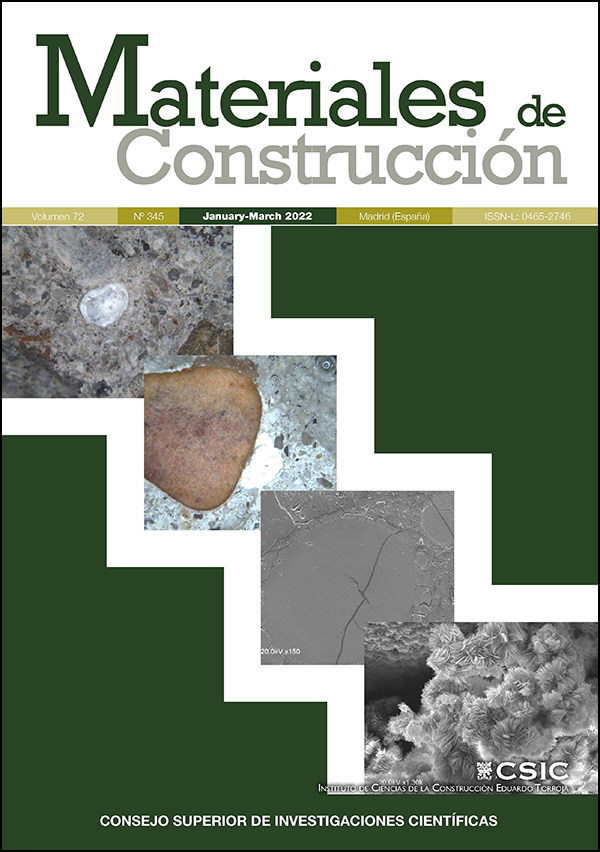Development of magnetic flux leakage device as a non-destructive method for structural reinforcement detection
DOI:
https://doi.org/10.3989/mc.2022.02421Keywords:
Magnetic flux leakage method, Concrete, Metal reinforcement, RebarAbstract
Non-destructive measurement techniques are used to identify engineering construction components without causing any negative effects on their use as construction components in the future. Contrary to this, conventional techniques cause damage to the structure. The magnetic flux leakage (MFL) method is a non-destructive test technique commonly used to assess the physical status of construction materials. Within the framework of this study a magnetic flux leakage device was produced to detect the properties of reinforced concrete construction elements. The produced magnetic flux leakage device was used for measurements in 4 different test systems created in the laboratory environment and the results were interpreted. Thus, it was revealed that the detection of reinforcement in structures can be performed more rapidly and without damage with the MFL method.
Downloads
References
Karakuş, M.; Tütmez, B. (2006) Fuzzy and multiple regression modelling for evaluation of intact rock strength based on point load, Schmidt hammer and sonic velocity. Rock Mech. Rock Eng. 39 [1], 45-57. https://doi.org/10.1007/s00603-005-0050-y
Vasconcelos, G.; Lourenço, P.B.; Alves, C.A.; Pamplona, J. (2007) Prediction of the mechanical properties of granites by ultrasonic pulse velocity and Schmidt hammer hardness. North American Masonry Conference June 3-7 Missouri USA.
Sharma, P.K.; Singh, T.N. (2008) A correlation between P-wave velocity, impact strength index, slake durability index and uniaxial compressive strength. B. Eng. Geol. Environ. 67 [1], 17-22. https://doi.org/10.1007/s10064-007-0109-y
Kurtuluş, C.; Irmak, T.S.; Sertçelik, I. (2010) Physical and mechanical properties of Gokceada: Imbros (NE Aegean Sea) island andesites. B. Eng. Geol. Environ. 69 [2], 321-324. https://doi.org/10.1007/s10064-010-0270-6
Sharma, P.K.; Khandelwal, M.; Singh, T.N. (2011) A correlation between Schmidt hammer rebound numbers with impact Strength index, slake durability index and P-wave velocity. Int. J. Earth Sci. 100 [1], 189-195. https://doi.org/10.1007/s00531-009-0506-5
Fort, R.; de Buergo, M.A.; Perez-Monserrat, E.M. (2013) Non-destructive testing for the assessment of granite decay in heritage structures compared to quarry stone. Int. J. Rock. Mech. Min. 61, 296-305. https://doi.org/10.1016/j.ijrmms.2012.12.048
Pamuk, E.; Büyüksaraç, A. (2017) Investigation of strength characteristics of natural Stones in Ürgüp (Nevşehir/Turkey). Bitlis Eren Univ. J. Sci. Technol. 7 [2], 74-79. https://doi.org/10.17678/beuscitech.305653
Işık, E.; Bakış, A.; Akıllı, A.; Hattaoğlu, F. (2015) Usability of ahlat stone as aggregate in reactive powder concrete. Int. J. App. Sci. Eng. Res. 4 [4], 507-514.
Işık, E.; Büyüksaraç, A.; Avşar, E.; Kuluöztürk, M.F.; Günay, M. (2020) Characteristics and properties of Bitlis ignimbrites and their environmental implications. Mater. Construcc. 70 [338], e214. https://doi.org/10.3989/mc.2020.06519
Karahan, Ş.; Büyüksaraç, A.; Işık, E. (2020) The Relationship between concrete strengths obtained by destructive and non-destructive methods. Iran. J. Sci. Technol. Transact. Civ. Engineer. 44, 91-105. https://doi.org/10.1007/s40996-019-00334-3
Okolo, K.W. (2018) Modelling and experimental investigation of magnetic flux leakage distribution for hairline crack detection and characterization. Wolfson Centre for Magnetics School of Engineering, Cardiff University. (PhD Thesis). https://doi.org/10.1063/1.4994187
Rao, B.P.C. (2012) Magnetic flux leakage technique. J. Non Destr. Test. Eval. 11 [3], 7-17.
Li, L.; Huang, S.; Zheng, P.; Shi, K. (2002) Evaluation of surface cracks using magnetic flux leakage testing. J. Mater. Sci. Technol. 18 [4], 319-321.
Ramirez, A.R.; Mason, J.S.D.; Pearson, N. (2009) Experimental study to differentiate between top and bottom defects for MFL tank floor inspections. NDT&E Intern. 42 [1], 16-21. https://doi.org/10.1016/j.ndteint.2008.08.005
Sun, Y.; Kang, Y. (2010) A new MFL principle and method based on near-zero background magnetic field. NDT&E Intern. 43 [4], 348-353. https://doi.org/10.1016/j.ndteint.2010.01.005
Tsukada, K.; Yoshioka, M.; Kiwa; T.; Hirano, Y. (2011) A magnetic flux leakage method using a magnetoresistive sensor for non destructive evaluation of spot welds. NDT&E Intern. 44 [1], 101-105. https://doi.org/10.1016/j.ndteint.2010.09.012
Göktepe, M.; Perin, D. (2012) Inspection of rebars in concrete blocks. Int. J. Appl. Electromagn. Mech. 38 [2-3], 65-78. https://doi.org/10.3233/JAE-2012-1409
Loa, C.C.H.; Nakagawa, N. (2013) Evaluation of eddy current and magnetic techniques for inspecting rebars in bridge barrierrails. AIP Conf. Proc. 1511, 1371. https://doi.org/10.1063/1.4789202
Shi, Y.; Zhang, C.; Li, R.; Cai, M.; Jia, G. (2015) Theory and application of magnetic flux leakage pipeline detection. Sensors. 15 [2], 31036-31055. https://doi.org/10.3390/s151229845 PMid:26690435 PMCid:PMC4721765
Wu, D.; Liu, Z.; Wang, X.; Su, L. (2017) Composite magnetic flux leakage detection method for pipelines using alternating magnetic field excitation. NDT&E Intern. 91, 148-155. https://doi.org/10.1016/j.ndteint.2017.07.002
Wilcke, M.; Walther, A.; Szielasko, K.; Youssef, S. (2018) The MFL technique - Basic application for PT cable break detection in concrete structures. MATEC Web of Conferences 199, 06013 ICCRRR 2018. https://doi.org/10.1051/matecconf/201819906013
Antipov, A.G.; Markov, A.A. (2018) A new MFL principle and method based on near-zero background magnetic field. NDT&E Intern. 98, 177-185. https://doi.org/10.1016/j.ndteint.2018.04.011
Sadr, A.; Okhovat, R.S. (2016) Extracting the region of interest from MFL signals. Turk. J. Elec. Eng. Comp. Sci. 24, 427-434. https://doi.org/10.3906/elk-1305-70
Myakushev, K.; Slesarev, D.; Sukhorukov, D. (2018) Magnetic flux leakage (MFL) method for nondestructive testing of prestressed steel reinforcement strands. 12th European Conference on Non-Destructive Testing (ECNDT 2018), Gothenburg 2018, June 11-15 (ECNDT 2018).
Published
How to Cite
Issue
Section
License
Copyright (c) 2022 Consejo Superior de Investigaciones Científicas (CSIC)

This work is licensed under a Creative Commons Attribution 4.0 International License.
© CSIC. Manuscripts published in both the print and online versions of this journal are the property of the Consejo Superior de Investigaciones Científicas, and quoting this source is a requirement for any partial or full reproduction.
All contents of this electronic edition, except where otherwise noted, are distributed under a Creative Commons Attribution 4.0 International (CC BY 4.0) licence. You may read the basic information and the legal text of the licence. The indication of the CC BY 4.0 licence must be expressly stated in this way when necessary.
Self-archiving in repositories, personal webpages or similar, of any version other than the final version of the work produced by the publisher, is not allowed.
Funding data
Sivas Cumhuriyet Üniversitesi
Grant numbers M-516
















